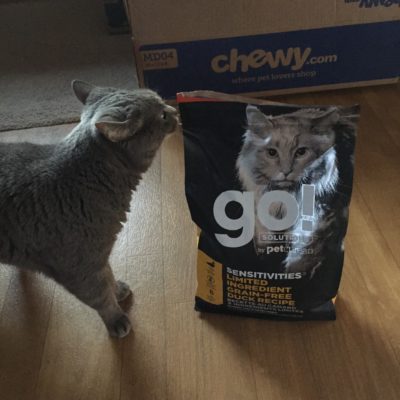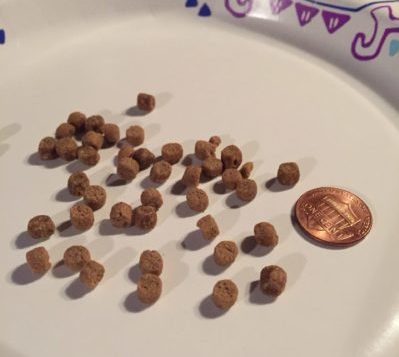
I have been feeding my cat with Petcurean Go Chicken & Turkey for a while. I don’t like feeding my cat the same dry food for too long so every two or three months I switch to a different formula. One dry food I usually feed my cat during these rotational periods is Go Sensitivities Limited Ingredient Duck. This review is a general approach considering some ingredients that could not be suitable for your feline friend. Also, I must mention that I complement this dry food with a high-in-protein wet food to feed my cat daily.
Go! SENSITIVITIES Duck Limited Ingredients:
De-Boned Duck, Duck Meal, Whole Dried Egg, Peas, Pea Flour, Tapioca, Lentils, Chickpeas, Chicken Fat (Preserved With Mixed Tocopherols), Flaxseed, Natural Flavour, Sodium Chloride, Choline Chloride, Calcium Carbonate, Dried Chicory Root, Phosphoric Acid, Potassium Chloride, Vitamins (Vitamin A Supplement, Vitamin D3 Supplement, Vitamin E Supplement, Niacin, L-Ascorbyl-2-Polyphosphate (A Source Of Vitamin C), Thiamine Mononitrate, D-Calcium Pantothenate, Riboflavin, Pyridoxine Hydrochloride, Beta-Carotene, Folic Acid, Biotin, Vitamin B12 Supplement), Minerals (Zinc Proteinate, Iron Proteinate, Copper Proteinate, Zinc Oxide, Manganese Proteinate, Copper Sulphate, Calcium Iodate, Ferrous Sulphate, Manganous Oxide, Sodium Selenite), Taurine, Dried Rosemary.
Guaranteed Analysis
Crude Protein 31.0% min – Crude Fat 15.0% min – Crude Fiber 3.5% max – Moisture 10.0% max – Ash 7.5% max – Magnesium 0.09% max – Omega-6 2.5% min – Omega-3 0.5% min.
Analysis of the first 5 Ingredients of Go! Sensitivities Duck
- De-boned duck: 4 stars. Duck is a good alternative protein to chicken. De-boned duck meat doesn’t carry too much water weight in the muscles.
- Duck meal: 5 stars. Highly concentrated protein. Duck meal is duck meat cooked at a high temperature and pulverized so no water is present when weighed.
- Whole dried egg: 2 stars. Shell-free dehydrated whole eggs. This ingredient provides high protein content and contains 9 essential amino acids such as Lysine, methionine, tryptophan, and valine, among others. Essential amino acids are very important for the basic functions of the cat’s organs. The bad part is that dried eggs are usually a waste product from the egg industry and it contains too much cholesterol.
- Peas: 5 stars. Good source of vegetable protein, fiber, and carbs.
- Pea flour: 3 stars. A carbohydrate alternative that is easily digestible for cats. Even though it’s a good source of energy, it’s always better to include animal fats instead.
Possible allergens in the formula
- Whole dried eggs
Caloric content & feeding recommendation
Metabolizable energy: 4,222 kcal/kg, 464 kcal/cup. For a regular-sized cat (between 10-13 lbs) that is not very active, the recommended portion is between 1/3 – ½ cup per day. For a more active cat, the suggested portion is between ½ – ¾ cup daily.
Type of kibble
The kibble size is small, with a round shape, and not very hard. My cat doesn’t have issues chewing on this food. Also, if you use an automatic feeder, this food provides the feeder with good portion accuracy. See the picture below:

What I like about this formula
- Grain & gluten-free
- The first 3 ingredients are proteins, of which “duck meal” is a highly concentrated protein.
- Peas are relatively low in the glycemic index, keeping their blood sugar levels at bay
- With limited ingredients, with is made for cats with a sensitive digestive system
- No chicken protein is present in the formula. Good for rotational feeding.
- Helps with the kitty’s bowel movements.
- Duck meal made with real duck, not with by-product meat
- No wheat, corn, or soy
- Dried chicory root protects the cat’s digestion and keeps the cat’s weight at bay
- A low ash content of 7.5% (guaranteed as maximum) prevents urinary issues.
- Good balance of Omega-3 and Omega-6
What I don’t like about this cat food
- Low total protein content (31%) for young adult cats. It could be higher, at least 35%.
- 3.5% of crude fiber* is on the higher side. For healthy cats, the range required is 1.4% to 3.5%. If your cat suffers from hairballs 3.5% of crude fiber could be beneficial. The ideal percentage is 3%.
- Dehydrated whole eggs contain too much cholesterol that may suffer oxidation over time.
- Pea flour could have been replaced by animal fat as the 5th ingredient.
- Tapioca, lentils, and chickpeas represent too many carbohydrates in the formula.
- The formula lacks fish oil, which is the best form of fatty acid for cats.
* Crude fiber is fermented by the gut bacteria present in the cat’s intestine producing short-chain fatty acids, which provide the cat’s intestines with the energy necessary to break down the nutrients. Too much fiber could produce less absorption of nutrients and also excess defecation.
My final thoughts (Update)
Update after nine months: After several months of feeding my cat Go Sensitivities Limited Ingredients, she remained free from any digestive issues, maintained a steady weight, and continued to engage in regular play sessions. However, after about nine months, I noticed a subtle change in Sophie’s appearance – her fur seemed slightly duller, and her play sessions, while still consistent, became shorter. Despite these observations, I still recognize the positive attributes of this formula. It’s free of chicken protein, low in ash, and boasts balanced minerals, all of which are beneficial for felines with food sensitivities. However, my experience suggests that while this formula is effective at maintaining a cat’s health initially, it may not provide sustained benefits for long-term use. The dulling of Sophie’s fur and shortened play sessions may not be directly attributable to an allergic reaction, but rather could indicate a need for dietary variety or other nutritional considerations, such as the absence of fish oil in this recipe, and a lower protein content compared to other formulas.
Bottom line
I suggest feeding your cat Go Sensitivities Limited Ingredient Duck as a rotational food to feed your cat a diet free of chicken protein, but just for three months at the longest. It’s worth noting that while this formula contains chicken fat, pure chicken fat shouldn’t trigger an allergic reaction in cats since fat doesn’t contain the allergen which is the chicken protein. However, if your cat has been diagnosed with chicken allergy and you worry about chicken fat, pick a different formula for your peace of mind and to avoid potential issues.
Get Go Sensitivities Duck dry food at Chewy with 35% off on your first Auto-ship, check it out. Or you can get it on Amazon here.
On behalf of one cat with chronic ear infections, and another that occasionally vomits, I’ve been trying to investigate chicken-free cat food formulas for some time now, and as is typical for internet sites, found a wealth of conflicting information. For example:
— while several bloggers cite chicken as the post prominent protein allergen, there are others that list a variety of proteins and grains EXCEPT chicken.
— while turkey and duck formulas are often recommended as alternatives for chicken-sensitive animals, several sites state that allergies to chicken (proteins, feathers, droppings) can easily be triggered by other fowl (more-so turkey than duck, some say)
— while you recommend GO! Solution Sensitivities Duck, its 11th ingredient is chicken fat, and several sites say chicken fat will trigger chicken allergies just as easily as chicken proteins. Could you explain?
Although Petcurean products appear on other recommended LID (Limited Ingredient Diets) food lists, another that often tops these lists is Natural Balance, and while you caution against high glycemic ingredients like potatoes, which appear in 6th or 8th place in some of their products, others like Green Pea+Duck, Green Pea+Salmon, Green Pea+Venison, as well as the LID High Protein Salmon or Tuna formulas contain no potatoes at all. Do you have any other concerns with those?
Hi Steve, pet food companies include Chicken, eggs, fish in most cat food products with makes pets addicted to these proteins, hence, the creation of food allergy due to excess of the same protein in the animal diet. That’s how it works. For this reason, is convenient and reasonable to do rotational feeding to cats often to avoid this problem from happening. The idea is not to get stuck with the same protein in the same cat food for over a year. Chicken fat is not defined as a protein allergen, which is the cause of allergy in cats, the cat’s addiction to chicken protein, and refusing to eat any food which doesn’t contain it, creates the allergy, the same with any other type of animal protein or ingredients, like dairy. Even though chicken fat is processed, purified, and doesn’t contain protein, it could be a problem if you already have a high allergic-to-chicken cat. My suggestion for rotational feeding is a way to prevent cats from developing a chicken allergy, but the same goes for other types of proteins in excess over a prolonged period of time. Regarding formulas with high content of fish, I don’t generally recommend them since they are usually highly addictive to the cat’s palate which creates allergy faster than chicken, they are usually in forms of meal which eliminates the essential fatty acids they could provide and in general cause some urinary tract issues, especially in male cats.